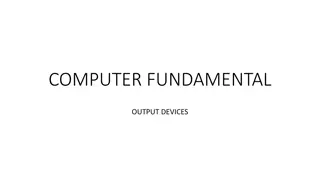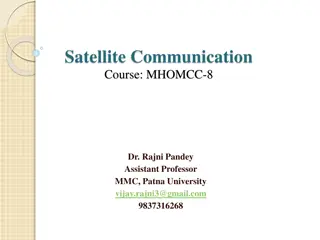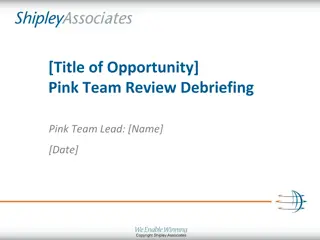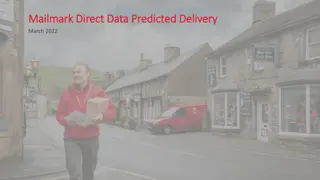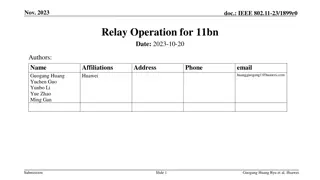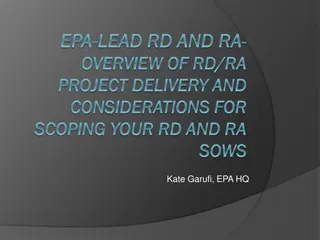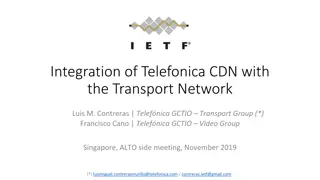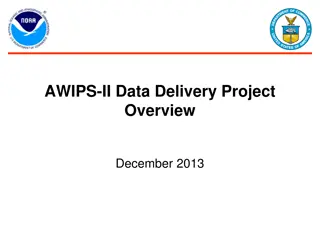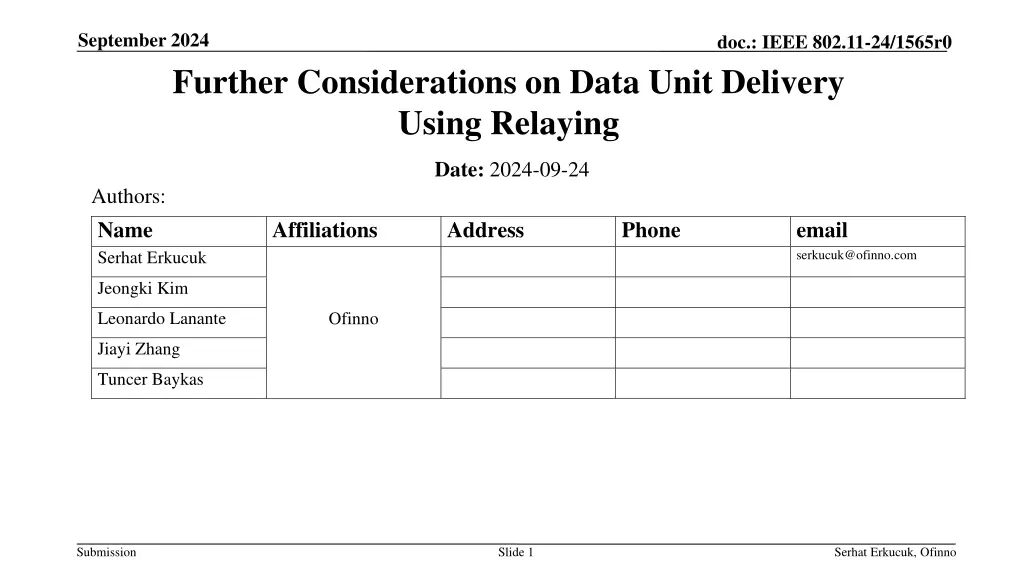
Enhancing Data Unit Delivery Using Relay Strategies
Explore the considerations for optimizing data unit delivery in relaying scenarios, focusing on enhancing throughput and reducing latency. Topics covered include conventional relaying methods, out-of-order delivery, and challenges at the destination STA side regarding error handling and support for OOO delivery.
Download Presentation

Please find below an Image/Link to download the presentation.
The content on the website is provided AS IS for your information and personal use only. It may not be sold, licensed, or shared on other websites without obtaining consent from the author. If you encounter any issues during the download, it is possible that the publisher has removed the file from their server.
You are allowed to download the files provided on this website for personal or commercial use, subject to the condition that they are used lawfully. All files are the property of their respective owners.
The content on the website is provided AS IS for your information and personal use only. It may not be sold, licensed, or shared on other websites without obtaining consent from the author.
E N D
Presentation Transcript
September 2024 doc.: IEEE 802.11-24/1565r0 Further Considerations on Data Unit Delivery Using Relaying Date: 2024-09-24 Authors: Name Serhat Erkucuk Affiliations Address Phone email serkucuk@ofinno.com Jeongki Kim Leonardo Lanante Ofinno Jiayi Zhang Tuncer Baykas Submission Slide 1 Serhat Erkucuk, Ofinno
September 2024 doc.: IEEE 802.11-24/1565r0 Introduction Rate-vs-range enhancement via relays has been an important consideration for 11bn [1-29]. In relaying for 11bn, effective throughput increase and reducing latency at the destination STA side have also been considered [8,15]. In this contribution, we consider some issues in data unit delivery in relaying while increasing the effective throughput. Submission Slide 2 Serhat Erkucuk, Ofinno
September 2024 doc.: IEEE 802.11-24/1565r0 Recap: Conventional Relaying In the conventional approach of relaying, if a data unit (e.g., MPDU) in a PPDU is received in error, only the data units before the failed data unit are forwarded by the relay station (STA-1) to the destination station (STA-2). E.g., in order (IO) delivery The relay STA has to wait until it receives the failed data unit correctly before it can forward to the destination station the data units received correctly in the initial PPDU. E.g., data units #3 and #4 are delayed Delay of data units #3 and #4 data units #3 and #4 arrive at the relay STA data units #3 and #4 arrive at the destination STA Submission Slide 3 Serhat Erkucuk, Ofinno
September 2024 doc.: IEEE 802.11-24/1565r0 Recap: OOO Delivery in Relaying According to out-of-order (OOO) delivery, data units may be forwarded to a higher layer without waiting for the completion of missing preceding data units in the reorder buffer. In a recent approach for relaying [15], OOO delivery has been considered for the relaying operation. Performed at MAC layer # 2 # 5 # 1 # 2 # 3 # 4 P AP P # 1 # 3 # 4 # 2 # 5 BA STA-1 P BA P # 1 # 2 # 3 # 4 # 2 # 5 P P STA-2 BA BA # 2 # 5 # 1 # 3 # 4 P P Delay of data units #3 and #4 data units #3 and #4 arrive at the relay STA data units #3 and #4 arrive at the destination STA Submission Slide 4 Serhat Erkucuk, Ofinno
September 2024 doc.: IEEE 802.11-24/1565r0 Problem at the Destination STA side Relay STA (STA-1) may receive from AP a PPDU comprising multiple data units to be relayed to the destination STA (STA-2). On decoding the PPDU, some data units may be decoded in error. For example, data unit #2 could be in error. STA-1 may transmit to STA-2 a PPDU comprising data units that are received successfully (i.e., OOO delivery). STA-2 may not support OOO delivery. STA-2 may only forward the MSDU of data unit #1 to the higher layer, and keep the MSDUs of data units #3 and #4 in the reorder buffer. Data units further to be received by STA-2 may also increase the number of MSDUs in the reorder buffer due to MSDUs not being forwarded to the higher layer timely. # 1 # 2 # 3 # 4 AP P # 1 # 3 # 4 STA-1 P BA # 1 # 2 # 3 # 4 P STA-2 # 1 # 3 # 4 P STA-2 may not support OOO delivery Submission Slide 5 Serhat Erkucuk, Ofinno
September 2024 doc.: IEEE 802.11-24/1565r0 Instructing Relay STA for OOO Delivery AP informing STA-1 regarding IO/OOO delivery capability of STA-2 Knowing whether the destination STA (STA-2) supports OOO delivery, AP may inform the relay STA (STA-1) about STA-2 s capability. AP transmits to relay station (STA-1): multiple data units that are to be forwarded by STA-1 to STA-2 an indication of OOO delivery support at STA-2 STA-1 transmits to STA-2 the PPDU including successfully received data units. For example, if the indication is OOO delivery supported and a data unit is received in error, STA-1 transmits to STA-2 data units received successfully without waiting for the successful arrival of the failed data unit. OOO/IO E.g., management frame, action frame Frame # 2 # 5 # 1 # 2 # 3 # 4 P AP P # 1 # 3 # 4 # 2 # 5 BA STA-1 P BA P # 1 # 2 # 3 # 4 # 2 # 5 Frame P P STA-2 BA BA # 2 # 5 # 1 # 3 # 4 P P data units #3 and #4 can be delivered to higher layer Submission Slide 6 Serhat Erkucuk, Ofinno
September 2024 doc.: IEEE 802.11-24/1565r0 Conclusion The use of OOO delivery in relaying may increase effective throughput and reduce latency at the destination STA side. AP informing relay station of the capability of a destination station supporting OOO delivery (or instructing the relay station to use IO/OOO delivery) may be needed to efficiently use OOO delivery in relaying. Submission Slide 7 Serhat Erkucuk, Ofinno
September 2024 doc.: IEEE 802.11-24/1565r0 References [1] 22/1908r1, UHR rate-vs-range enhancement with relay [2] 23/1139r0, Relay transmission in UHR [3] 23/1175r0, UHR Relay Follow-up [4] 23/1146r1, Relaying for low latency traffic in UHR [5] 23/1138r1, Features to consider for efficient relay operation [6] 23/1517r0, Follow up on the relay transmission [7] 23/1518r0, Evaluation for the relay transmission [8] 23/1450r1, Consideration on UHR relay architecture [9] 23/1838r0, Follow up on the relay transmission [10] 23/1839r0, Evaluation for the relay transmission [11] 23/1889r0, Considerations for relay operation in next generation Wi-Fi networks [12] 23/1899r0, Relay operation for 11bn [13] 23/1928r0, Considerations for relay operation in next generation Wi-Fi networks - part 2 [14] 23/1948r0, TXOP sharing based UL relaying [15] 23/1969r0, Consideration on UHR relay architecture [16] 23/1955r1, Considerations for relay operation in next generation Wi-Fi networks - part 3 [17] 24/105r0, TXOP for relay communication in 11bn [18] 24/386r0, Lower MAC relay follow-up [19] 23/1840r2, Relay for 11bn [20] 23/2217r1, Some thoughts on relay improvement [21] 24/74r1, Relay operation follow-up [22] 24/820r0, SCS proxy for relay [23] 24/650r1, A case for opportunistic relaying [24] 24/887r0, Consideration on relay operation for 11bn [25] 24/385r1, Discussion on 11bn relay operation [26] 24/1038r0, Channel sounding for UHR relay [27] 24/819r1, TWT for relay [28] 24/1572r0, Enhancements on relaying for UHR [29] 24/1578r0, Sounding procedure for relay operation Submission Slide 8 Serhat Erkucuk, Ofinno



